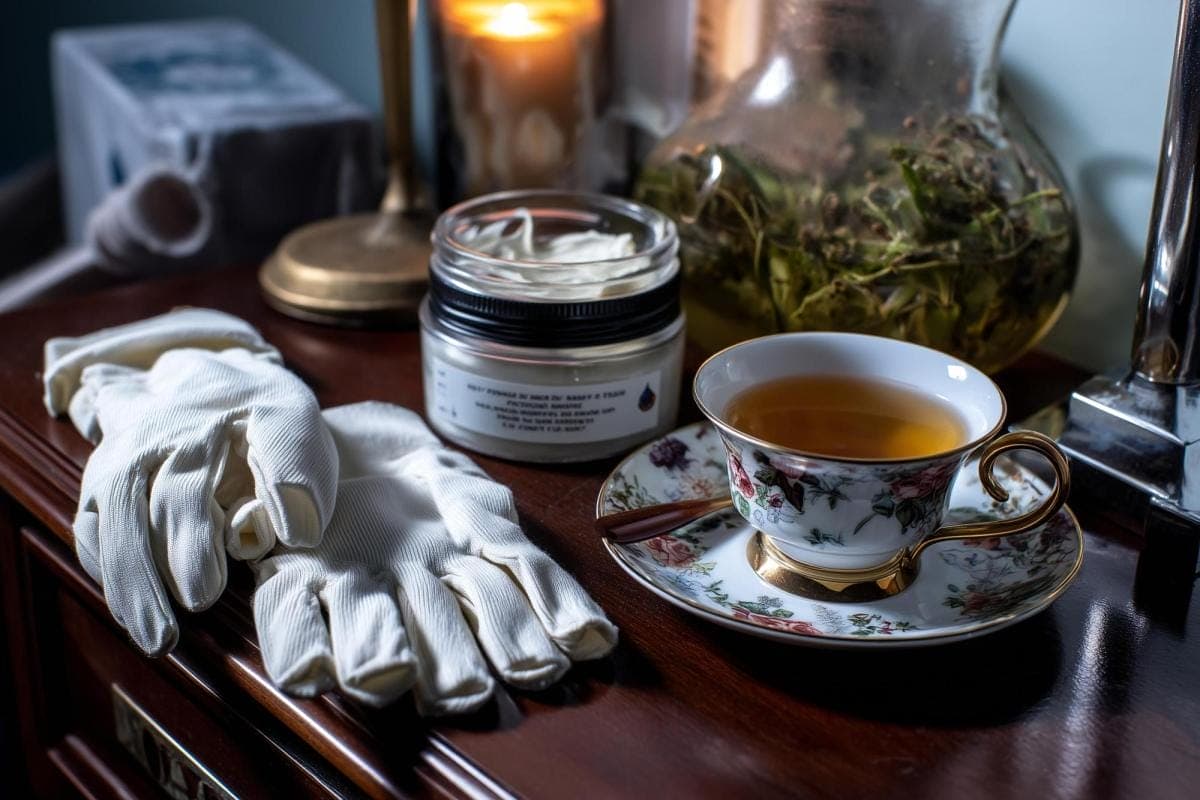If you click on links we provide, we may receive compensation.
Skin is a living barrier and nowhere is that fact more obvious than on your hands. Unlike the face, the dorsal surface of the hands has just a whisper of sebaceous activity. That means fewer natural oils cushion the tissue from soap, paper towels, or a chilly gust. Add hot water – a solvent that melts sebum on contact – and a single wash can remove half the protective layer you woke up with. Repeat that wash ten times a day and dehydration is inevitable.
There’s also anatomy at play. The epidermis on the palms is thicker and better equipped for friction, but it lacks the hair follicles that deliver sebum in other areas. On the flip side, the backs of your hands are thin and delicate, making fine lines appear earlier than you’d expect. Because those two surfaces have dramatically different needs, the ideal cream must bridge two extremes: it cushions the palm without feeling slippery, and it cocoons the back without vanishing in thirty seconds.
Weather matters as well. Winter air can hold less water than summer air, so every breath you take indoors is quietly wicking moisture from exposed skin. Central heating accelerates the process. Even in warm climates, aggressive air conditioning lowers relative humidity, creating a mini‑desert around your desk. Over time, the stratum corneum – that outermost layer of dead yet vital cells – loses flexibility. When it can no longer stretch, it cracks, and those microscopic fissures allow deeper evaporation.
Key Ingredients That Rescue Thirsty Skin
Glycerin tops most ingredient lists for a reason. It’s a humectant, pulling water from the air and from deeper layers of skin, then holding it in place like a microscopic sponge. Urea works similarly but also breaks down hardened protein bonds, so rough patches feel smoother within days. Shea butter behaves quite differently; its large lipid molecules stay closer to the surface, sealing everything in and softening the appearance of fine lines. Together with ceramides – the mortar that fills gaps between skin cells – these ingredients rebuild a barrier that survives the next hand‑washing.
I watch for formulas that pair humectants with occlusives because a humectant alone can’t work magic if every droplet evaporates five minutes later. Petroleum jelly is a classic occlusive, though many find it too greasy for daytime. Plant waxes like candelilla or jojoba give a lighter feel, while dimethicone offers slip without stickiness. If your skin reddens easily, look for colloidal oatmeal or panthenol to soothe micro‑inflammation triggered by constant friction.
Fragrance is a personal call. A fleeting lavender whiff can make a work break feel indulgent, but perfume molecules sometimes irritate chapped skin. On days when the cuticle line looks ragged, I reach for a fragrance‑free tube to dodge the sting.

Choosing A Formula That Fits Your Routine
Your perfect cream depends on when and where you plan to use it. I keep a lighter, fast‑absorbing option beside my keyboard so I can jump back to typing without leaving oily fingerprints. In my coat pocket lives a richer balm that can withstand cold wind during dog walks. At night, a concentrated ointment earns a spot on the nightstand; hands soak it up while I sleep, and I wake without that uncomfortable morning tightness.
Texture signal’s function. If a cream feels almost watery and sinks in under a minute, it likely relies on water‑soluble humectants and just a whisper of oil. Those are ideal for office hours. Thick formulas that come in jars or metal tubes often use higher oil content or waxes. They stay on the surface longer, which is exactly what you want before braving freezing rain or facing a sink full of dishes.
Packaging also nudges behavior. Pump bottles encourage frequent small doses, helping you reapply after every wash. Flip‑top tubes reduce air exposure, preserving active ingredients like niacinamide or vitamin E. Metal tubes – borrowed from old‑school apothecaries – shield formulas from light and oxygen, so sensitive ingredients such as shea butter remain stable.
Real World Favorites That Deliver
When my hands feel as dry as paper, I reach first for Neutrogena Norwegian Formula Hand Cream. One pea‑sized dab unleashes a glycerin concentration so high the texture borders on gel. It spreads easily, creates a satin film, and survives two rounds with the office soap dispenser.
For people whose jobs involve concrete, gardening, or plain old parenting, O’Keeffe’s Working Hands earns its cult following. The green jar hides a dense formula that melts on contact, filling cracks you didn’t realize you had. I’ve watched a single overnight application erase the sore redness around a hangnail.
Some afternoons demand a sensory treat, and that’s when I uncap L’Occitane Shea Butter Hand Cream. Twenty percent shea provides a buttery feel, yet somehow the finish never feels waxy. The subtle floral scent fades before the next Zoom call, making it office‑friendly.
Sensitive‑skin readers often write to ask whether fragrance‑free really makes a difference. Aveeno Skin Relief Intense Moisture Hand Cream answers that question with oat‑derived soothing agents and no added perfume. During allergy season, when my eczema‑prone knuckles rebel, this is the only product that calms the itch without leaving polish‑destroying residue.
Finally, for people chasing both softness and anti‑aging benefits, Eucerin Advanced Repair Hand Cream blends ceramides with alpha hydroxy acids. The AHAs nibble away at rough cuticles while ceramides lay fresh mortar between skin cells. Over a fortnight, nails look glossier and age spots less stark.

Tips To Keep the Hydration Locked In
Even the finest formula can only do so much if you use it once a day and forget about it. I set tiny rituals: a pump after each wash, a thicker layer before stepping outside, and a final massage while the kettle boils for bedtime tea. Wearing cotton gloves overnight sounds fussy, yet the payoff next morning convinces most skeptics in one try. If gloves feel claustrophobic, wrap hands around a warm mug for a minute to let the cream melt deeper, then wipe off excess with a tissue.
Technique matters too. Start with a pea‑sized dollop, rub palms together, then interlace fingers so product reaches the webbing. Circle thumbs over the opposite palm to hit callused spots, and never skip the backs of fingers – that’s where fine lines debut. Work any remainder into cuticles; consistent hydration reduces the temptation to pick. Remember, moisturized nails grow stronger because the surrounding skin supports them.
Hydration works from the inside as well. A diet rich in essential fatty acids – think salmon, walnuts, or flaxseed – supplies lipids that skin can convert into ceramides. While no amount of water intake can directly rescue the stratum corneum, adequate hydration does improve overall cell turnover, making topical moisturizers more effective.
Frequently Asked Questions About Hand Creams
Do I need separate day and night hand creams?
You can certainly get by with one multitasker, but splitting duties lets you fine‑tune texture. Lightweight emulsions keep keyboards clean during daylight, while richer balms create an occlusive shield overnight. Switching also extends the life of each tube, because you’re using the right amount at the right time rather than over‑compensating.
Why does my skin still feel dry after cream?
You may be under‑applying or washing too soon after. Give a product at least five minutes to form its barrier before grabbing soap again. Also check the ingredient list; if water dominates and oils appear only at the end, the formula might lack enough occlusives to seal moisture. Look for glycerin in the top three ingredients plus oils or dimethicone farther down.
Are petroleum‑based products safe?
Pharmaceutical‑grade petrolatum is purified and sits on the skin surface without clogging pores. Still, some dislike the greasy feel. If that’s you, try a dimethicone‑rich cream for a lighter finish. Plant waxes such as sunflower or rice‑bran also provide an alternative occlusive layer with a quicker dry‑down.
Can hand cream double as foot cream?
Technically yes, but feet often need stronger keratolytics like higher‑percentage urea or salicylic acid. Using a foot‑specific product can speed softening of calluses. However, in a pinch, a thick hand balm will prevent cracks in heels overnight.
How long until I see results?
Surface softness appears within minutes, yet structural change – smoother cuticles, fewer hangnails, diminished redness – takes consistent use. Give a new cream two weeks of daily applications before judging performance. Track progress with photos if you’re skeptical; I’ve watched clients convert from occasional users to devotees once they compare before‑and‑after shots.




